Dead insects are cited as a usual feature in crop circles, as if it was a quasi-systematic characteristic among the other alleged systematic strangeness characteristics.
W. C. Levengood and Marilyn J. Ruben wrote in 2003 that there were fourteen unusual features in crop circles [1]. The twelfth feature is given as:
"Point 12) Insects adhering to seed heads on wheat plants within crop formations."
Eltjo Haselhoff writes about it in the section "The dead flies enigma" in his book "The deepening complexity of crop circles":
"Such a phenomenon had never been seen before and no satisfactory solution could be devised."
Almost all crop circles proponent websites are repeating this.
I wondered whether this is true. I suspected that the dead insects are only rarely found in crop circles, that they are not a systematic characteristic at all, but something that has been noticed only on occasion on some circles, and later became part of a crop circle mythology as if it wasn't only rarely that dead insects are found in crop circles.
I was right. Most crop circles do NOT have dead flies. Only some, or few, have dead insects.
For example, the collection of laboratory reports by W.C. Levengood (at http://www.bltresearch.com/labreports.html) list 16 laboratory reports on 16 different crop circles (only 4 of the 16 are really published there, most are only listed, with a brief summary of the crop circles strangeness feature.)
Only one (July, 1998: Cherhill, Wiltshire (U.K.)) of these 16 reports mentions multiple dead insects in the crop circle.
Everyone can check this: dead flies are NOT a usual characteristic of crop circles. They are found only occasionally, and thus should not have been introduced without further thinking as an intrinsic characteristic of the crop circles.
Second, I wondered whether there is a natural explanation for the dead insects. Any sensible researcher looking into a problem starts by a search of the existing literature on that problem, instead of just believing there is no solution and trying one of his own, or not.
I noticed that almost invariably, proponent literature seems to take for granted that there is no natural explanation for the dead flies in crop circles. But it took me only a minute to find out that there is a solution.
The solution WAS FOUND IN 2003 by Francesco Grassi, an engineer, Secretary of CICAP Lombardy. CICAP is the Comitato Italiano per il Controllo delle Affermazioni sul Paranormale, very equivalent to CSICOP in the US. It is a skeptics group that claims that there is no paranormal stuff and tries to solve so-called paranormal mysteries, and often they do.
The solution was published in Grassi's article "Anomaly or natural phenomenon?" in June 2003, that can be found at: http://www.cropfiles.it/docs/Dead_Flies.pdf The article was published in the book containing the proceedings of the VII and VIII National Congress of CICAP (Reggio Emilia 2001 - Turin 2003, see: http://www.cicap.org/prometeo/lb_3255.php)
Another version of the solution by Grassi is at http://www.cicap.org/crops/en/006.htm
Grassi starts by some history of the mystery, citing Eltjo H. Haselhoff, Ph.D. in Theoretical and Experimental Physics, in his book "The deepening complexity of crop circles". Haselhoff reminds that the dead fly mystery started on July 17, 1998, when Dutch researcher Janet Ossebaard found that a lot of dead flies were stuck to the seeds of the wheat plants in a crop circle. Some insects appeared living, but she noticed they were dead. Many had their wings stretched. Some had like exploded: legs, parts of the bodies, wings and heads were spread on the spikes. Other were still alive but like paralyzed.
Ossebaard collected some of the dead insects and sent them to an expert at the London Natural History Museum.
The expert immediately found the solution, but it is then said that deeper analysis had excluded that solution (however the nature of the deeper analysis is not indicated).
Grassi noticed that Haselhoff's book does not contain any photographs of that crop circle containing the dead flies, the location is not even specified.
He thus looked for Ossebaard's original article "The Dead Flies Mystery", fins out that the location of that crop circle is Cherhill in Wiltshire, England, and finds the photograph of that crop circle:
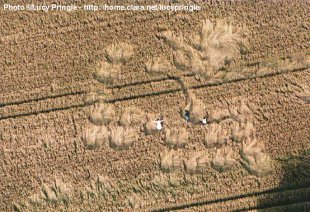
|
That crop circle is very far from impressive indeed, to the point that to me it could even have been caused by a whirlwind!
Remember my introduction note? I indicated that Levengood, among 16 reports listed on the BLT Research website, has only 1 where dead flies are reported. That's the one!
The report is unpublished. Grassi does not fail to note the obvious and fatal problem of the lack of data and lack of accessible and documentation. About that crop circle, he finds:
"I can deduce that - evidently - not all crop circle researchers agree with the statements that the 'Almost anonymous observers' sent to CICAP. In fact, the circle of the dead flies is just horrible, and we can just as safely assume that the 'Almost anonymous observers' never observed the 'perfection' of this formation they apparently consider genuine, otherwise they would never have committed such a 'faux pas'."
Just as I noted before that there is practically NO decent documentation on the crop circle case with dead insects.
Grassi found the solution in Haselhoff's book, taking it at the point where the expert at the London Natural History Museum gave it to Ossebaard:
The flies were dead because of a fungi: Entomophthora muscae.
"Muscae" means fly in latin.
"Entomophthora" derives from the composition of Greek words "ento" meaning insect, "tomo" meaning and "internally cut", "carved", and phtora meaning destruction.
This fungus attacks and destroy insects organisms as they are still alive.
Here is what the expert told:
"Sounds like an epizootic of a fungal disease, most probably caused by Entomophthora muscae or one of its close relatives. It often causes rather spectacular mortality events like the one you describe. E. muscae infects flies when the spores land on them, then germinate and grow right through the cuticle. The fungus then proliferates inside the fly, essentially devouring it from the inside. Infected hosts often climb up high before death and hang on tight [to the plants] or are cemented down by outgrowths of the fungus. This is thought to facilitate dispersal of the fungus, which produces forcibly discharged spores. The spore-producing structures emerge from between the abdominal segments after death, shoot off their spores, and then collapse, so in older specimens it is sometimes hard to see evidence of the fungus, and the dead flies look strangely normal, except that they are dead and stuck onto their substrate."
Grassi contacted Janet Ossebaard to get more precise information, photographs and the lab report. Ossebaard did not have the lab reports, she told that Bert Janssen could have them. Janssen said the reports were packed in some box of his before moving house and were not easy to find.
Grassi asked Janssen if he could remember the lab report's content, and he said that "The flies were partially covered with some kind of white substance which indicated that the cause of death was a fungus."
Grassi asked her why this explanation was ruled out and he said that "there should have been some kind of indicator which was missing and therefore their death could not have been caused by a fungus" which I find to be totally unsatisfying. A lost report, and no correct reason against the fungi explanation? This is not science.
Ossebaard sent a photograph, and it did show the white substance. This detail was of course interesting: when the fungi have finished eating the insect, it propagates around it, it sporulates. This is the white substance.
Grassi shows that all the other signs of the fungi match the steps of the fungi attacks, refer to the original article.
Grassi has also thought about Haselhoff's microwave theory. On reading the dead flies descriptions by Ossebaard, Haselhoff thought that microwave might explain the "exploded" characteristics of some of the files. Grassi debunked this explanation by showing that flies put in a microwave oven do not explode, do not spread their wings, do not stick, and show a "cooked" appearance very different to that indicated in dead flies of the crop circle that seemed alive, not cooked.
Obviously the proponent argument is not just that there are dead flies, but that there are dead flies in the crop circles.
But there is absolutely no indication whatsoever that there are no dead flies outside crop circles.
A bit of thinking lead me to the explanation, should it reveal that there are dead flies in crop circles more than outside crop circles:
Fungi spores do not travel easily to the insects' bodies. For that to happen on an anomalous wide scale, the spores must be brought to the insect's body by additional mechanism than normal sporulation.
Wind is such a mechanism. Spores can be carried by the wind on larger distance than usual sporulation in calm air. Indeed, the initial crop circle in which Ossebaard found the dead flies does seem caused by whirlwind rather than by land artists. The whirlwind could have caused more spores to reach more insects there. But obviously crop circles in general are not caused by the wind, which could never explain the complex designs.
What happens if they are caused by hoaxers and land artists?
The plants are disturbed, agitated, flattened. The spores of the fungi are thus also agitated and reach the insects more than usual.
Thus, it would not be surprising but natural if there were more dead insects disturbed ecology of the crop circle than outside. As often happens, the ecological disturbance causes the epidemic!
Another possibility is related to the number of stems that stand straight. Inside the crop circles, very few stems are straight, most are flattened. The dead flies are found at the stop the stems. As we saw, this is consistent with the fungi, while it makes no sense within paranormal theories (why would aliens or whoever stick flies at the top of the stems? Why would flies be at the top of the stems when the mysterious waves of an alleged ball of light hits?)
So, inside the crop circles, there only a few stems for the flies to land on, while there are a huge number of stems outside the circle. Statistically, this creates, for the amateur crop circle investigators, the illusion that there are many dead flies inside the crop circles. They might be just as many outside, but they are simply much less noticeable.
When reading crop circle proponents material on the Internet, it is apparent that there are practically only few crop circles with dead flies, and that the whole mystery has been inflated by commentators who fail to provide the useable data and merely repeat the dogma. One of them writes:
"In some formations, flies have been found stuck to the crop, by their wings, as if the wings have partially melted."
In all these texts, the location indication is merely the repeated leitmotiv: "in some circles."
I found zero evidence of flies stuck to the crop by their wings!
"In 1998, several formations in England were found to contain dead flies adhered to the plant stalks, which were dehydrated as if they had been "baked," consistent again with the possible involvement of some form of microwave-type energy."
The only "formation in England" in 1998 that I can find is again that very same Cherhill in Wiltshire. And note the expression: "consistent with possible involvement" of microwaves. This is far from evidence of microwave action!
Another text claims:
"In a couple of formations, numerous dead flies were found stuck by their tongues..."
Stuck by their tongues? We will see how this explains.
Only occasionally, the documentation is a little better. And when it is, the fungi theory is obviously the correct one.
"Elles sont mortes, figées sur les tiges, la trompe collée sur les épis. Pétrifiées ou paralysées, elles sont visiblement en parfait état."
(i.e. "They are dead, stuck on the stems, the trump glued. Paralyzed or shocked, they are obviously in a prefect state.")
This description is given of dead flies found in a 2004 crop circle at:
http://www.culture-crop.com/2004beemilkhill4.htm
In a perfect state? Not so!
The three pictures underneath show dead flies found at this crop circle:
I added the green lines to attract your attention to a feature appearing with more or less importance in these dead flies. They look like bees... They have stripes around the abdomen and some stuff under the belly like bees carrying pollen. But these are flies nevertheless. Flies with yellow stripes gathering pollen? This should have caught the attention of the investigator(s) but it did not.
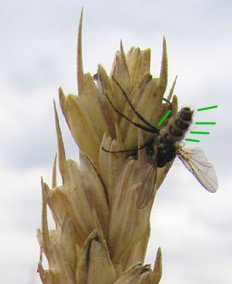
|
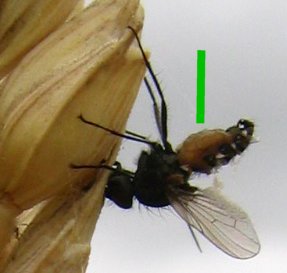
|
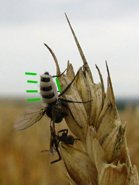
|
This stuff round their abdomen segments and under their belly is the Entomophthora Muscae fungi on the verge of sporation!
See http://www.virtualmuseum.ca/Exhibitions/Mushroom/English/Species/entomophthoramuscae.html :
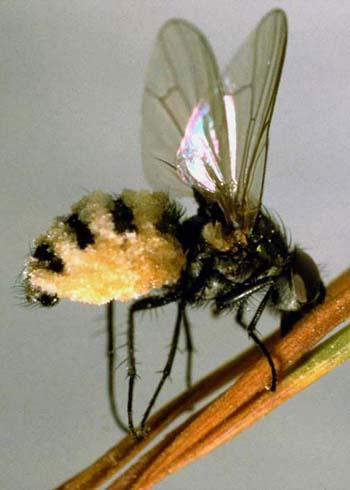
|
The investigators claimed that the flies there were in "perfect state", but they did not see what was in front of their eyes...
Dead flies inside crop circles are far from being intrinsic features of crop circles.
Dead flies are found outside crops circles too, but no investigator did bother to find how this happens.
If there were more dead flies inside than outside crop circles, it would only be natural.
The so-called "crop circles experts" have failed, again, to see the obvious natural explanation of an alleged strangeness of the crop circles.
Dead flies in crop circles are not cooked by microwave. They are eaten alive by fungi.
And consequently, the proof that the crop circles are not made by very human land-artists or pranksters must be found elsewhere.
In Italian: